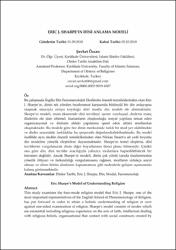| dc.contributor.author | Özcan, Şevket | |
| dc.date.accessioned | 2021-01-14T18:19:14Z | |
| dc.date.available | 2021-01-14T18:19:14Z | |
| dc.date.issued | 2018 | |
| dc.identifier.issn | 2147-7256 | |
| dc.identifier.issn | 2618-6497 | |
| dc.identifier.uri | https://app.trdizin.gov.tr/makale/TXpZMk9ERTBOQT09 | |
| dc.identifier.uri | https://hdl.handle.net/20.500.12587/13497 | |
| dc.description.abstract | Bu çalışmada İngiliz Din Fenomenolojisi Ekolünün önemli temsilcilerinden olan Eric J. Sharpe’ın, dinin tek yönden incelenmesi karşısında bütüncül bir din anlayışına ulaşmak amacıyla ortaya koyduğu dört modlu din modeli ele alınmaktadır. Sharpe’ın modeli, iman ekseninde dinî tecrübeyi içeren varoluşsal, dinlerin inanç ilkelerini ele alan zihinsel, inananların oluşturduğu sosyal yapılara temas eden organizasyonel ve dinlerin ahlaki yapılarına işaret eden ahlaki modlardan oluşmaktadır. Bu modele göre her dinin merkezinde farklı bir mod yer alabilmekte ve dinler arasındaki farklılıklar bu çerçevede değerlendirilebilmektedir. Bu model özellikle aynı ekolün önemli temsilcilerinden olan Ninian Smart’a ait yedi boyutlu din modeline yönelik eleştirilere dayanmaktadır. Sharpe’ın temel eleştirisi, dinî tecrübenin vurgulanarak dinin diğer boyutlarının ikinci plana itilmesidir. Çünkü ona göre din, dini tecrübe aracılığıyla yalnızca vicdanlara hapsedilebilecek bir fenomen değildir. Ancak Sharpe’ın modeli, dinin çok yönlü tarzda incelenmesine yönelik ihtiyacı ve farkındalığı vurgulamasına rağmen, modların oldukça soyut olması ve dinin bütün alanlarını kapsamaması gibi nedenlerle gelişim aşamasında kalmış görünmektedir. | en_US |
| dc.description.abstract | This study examines the four-mode religion model that Eric J. Sharpe, one of the most important representatives of the English School of Phenomenology of Religion, has put forward in order to attain a holistic understanding of religion in over against one-sided examination of religion. Sharpe's model consists of modes which are existential including religious experience on the axis of faith, intellectual dealing with religious beliefs, organizational that contact with social constructs created by believers and ethical that points to the moral structures of religions. According to this model, there might be a different mode in the center of each religion and the differences between the religions might be evaluated in this frame. This model is based on criticism of the seven-dimensional religion model of Ninian Smart, one of the most important representatives of the same school. The main criticism of Sharpe is that the other dimensions of religion are pushed into the background by emphasizing religious experience. Since, according to him, religion is not a phenomenon that can only be confined to conscience through religious experience. However, although Sharpe’s model emphasizes that need and awareness of the need to study religion in a multifaceted way, the model appears to have remained in the developmental stage due to the fact that the modes are highly abstract and do not cover up all areas of religion. | en_US |
| dc.language.iso | tur | en_US |
| dc.rights | info:eu-repo/semantics/openAccess | en_US |
| dc.title | Eric J. Sharpe’ın Dini Anlama Modeli | en_US |
| dc.title.alternative | Eric Sharpe’s Model of Understanding Religion | en_US |
| dc.type | article | en_US |
| dc.identifier.volume | 0 | en_US |
| dc.identifier.issue | 11 | en_US |
| dc.identifier.startpage | 343 | en_US |
| dc.identifier.endpage | 376 | en_US |
| dc.relation.journal | Amasya Üniversitesi İlahiyat Fakültesi Dergisi | en_US |
| dc.relation.publicationcategory | Makale - Ulusal Hakemli Dergi - Kurum Öğretim Elemanı | en_US |
















